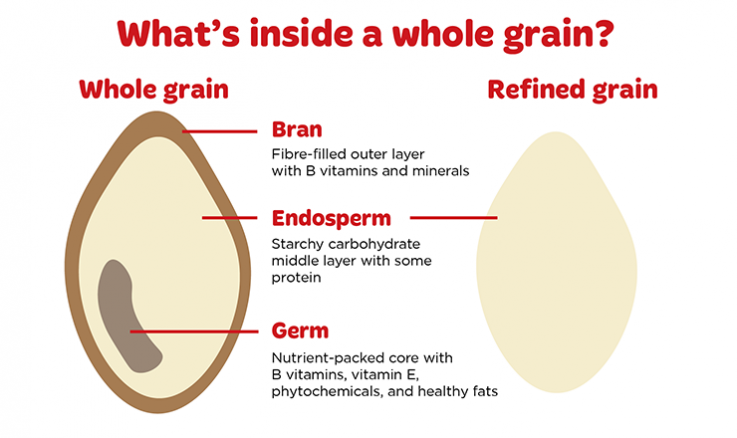Hey all!
As you know, it is heart health awareness month, and I wouldn’t be a dietitian if I didn’t talk about the heart-healthy diet this month! So here we go….
To summarize and put it simply, a heart-healthy diet is a diet that includes all food groups and all foods in proper portion on moderation that is especially full of whole grains and fruits and vegetables for adequate fibre intake, lean meat, skinless fish and poultry, plant-based proteins, heart-healthy fats and oils that include nuts and seeds and overall providing a colourful nutrient-dense plate at every meal. This diet is also lower in sodium and added sugar that emphasizes the intake of whole foods, minimally processed and nutrient-dense as often as possible. It limited tropical oils and other sources of saturated fat, excludes trans fats and does allow for alcohol in moderation as long as there is a provider’s approval.
As you have seen my write about before this is how your plate should be broken down:

For the next two weeks I will break the heart healthy diet into two parts, so it is easier to digest 😉 pun intended!
For this week’s blog we will focus on:
- Whole grains
- Fruits
- Vegetables
- Fibre
The leftover categories and topics will be left for next weeks blog, so be sure to check back!
- Whole Grains
Whole grains are defined as the entire grain and all of its components that include the bran, endosperm and germ. You can see the comparison between as whole grain and refined grain below. You will notice that the refined grain only has calories and very little nutrition. This is why we recommend the whole grain over the refined grain for the simple fact that it is more nutrient-dense- meaning it has more nutrients per the number of calories it provides. A large component to note is the FIBER, which I will be getting into in a little bit.

Here are some examples of whole grains:
- Brown rice
- Whole grain bread
- Oats
- Amaranth
- Sorghum
- Whole corn
- Buckwheat
- Barley
- Wheat berries
- Whole wheat
- Fruits and Vegetables
Fruits and vegetables are plants that are loaded with vitamins, minerals, and fibre! They are extremely nutrient-dense as they are low in calories but LOADED with nutrients. They also have a component called antioxidants. These are important as they help to reverse cell damage and prevent choric disease among other things. Eating all forms of fruits and vegetables is a great way to include a variety. For example, did you know that we should include fresh, frozen, canned and dried fruits and vegetables in our diet and that they are ALL nutritious?! YES! We just want to make sure that the frozen, canned, and dried fruits have no added sugar sources for the fruits and no added fat or sodium sources in the vegetables. But let’s say the canned fruit is in syrup rather than 100 % juice, or the canned vegetables have added salt… simply drain the syrup/water and rinse the fruit or vegetable for 2-4 minutes and you can remove so much of that added sugar or salt and still get the nutrition! Sometimes this can be a more affordable option over fresh, especially when items are not in season! AND they have a much longer shelf life, meaning less waste! Did I mention how convenient they are, you don’t have to chop or cut, they are ready when you are! Many times, I hear people say that the canning process causes nutrients to be lost- NOT TRUE😉 in fact sometimes canned and frozen fruits and vegetables can have MORE nutrition than their fresh counterparts as they have been picked at the peak of ripeness and canned or frozen within 3-4 hours which actually preserves or “locks” the nutrients in! So, all in all, the takeaway is to include ALL forms of fruits and vegetables including fresh, frozen, canned and dried! Finally, don’t forget to have a variety of colours! This is because all the different colours provide different nutrients.
- Fiber
In the above categories I just discussed you notice the whole grain and the fruits and vegetables are good sources of fiber and that it is very important. So WHY is that the case? WHY do we want and need fiber especially when it comes to our heart health? Fiber does SO much for our bodies when it comes to overall health and we should have AT LEAST 25 grams per day, but more is better and here is why:
Fiber helps to keep us fuller for longer which can aid in weight management and we know that keeping a healthy weight is important for helping to treat and or prevent heart disease. It also helps to control blood sugar levels- when we eat something with fiber are blood sugar levels don’t spike and dip, they remain more consistent. This is important because many time diabetes and heart disease go hand in hand. Fiber also helps to reduce total cholesterol levels and especially the LDL cholesterol levels (bad cholesterol levels). The fiber literally attaches to the cholesterol and pulls in out of our body during a bowel moment! How cool is that?! Fiber is also important for overall gut health and the promotion of our gut microbiome or healthy gut bacteria to all us to digest our food more effective and efficiently being able to extra the most nutrients possible to serve our body best!
I hope this was helpful in providing a basic outline of a heart healthy diet that everyone would benefit from as well as digging a big deeper into why including whole grains, fruits and vegetables as well as fiber is so essential in a heart healthy diet.
As always comment below with any questions!
Cheers!
Ashley

